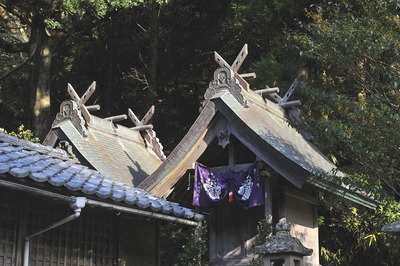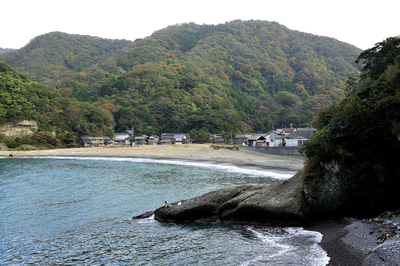Inome-ura
| Bay Name | Inome |
|---|---|
| Shrine Name | (Former) Ooto Daimyoujin } (Current)Ooto-jinja |
| Deity | Ootoshi-no-kami |
| Location | Izumo-shi Inome-machi, Inome 229 |

Since the Edo period, it’s been thought that the deity ‘Ootoshi’ kami has been the tutelary guardian of Inome village. The ‘Koritoriuta’ includes mention of ‘Ohotoshi’ in its verses. Since the time of the 18th century ‘Unyoushi’, the shrine hall has been separated into two shrines, the’ upper’ and ‘lower’. This terminology is still used in the present day.
According to the Kojiki, Susano had two children with Kamu-o-Ichihime, the wife of his brother (Ooyamatsuminokami). The two, ‘Ohotoshi’ and ‘Ukanomitama’, in other words the elder brother of ‘Inari’, the agriculture kami. Despite the literal meaning of ‘great year’ within the name ‘Ohotoshi’, it’s believed to be the kami that protects the harvest gathered over one agricultural year.

Ootoshi-jinja is enshrined alongside the remains of the elementary school across the river from the bus-stop which is to the side of the coast down the shore after crossing the Inome gorge from Izumo-Taisha.
One feels deep emotions when picturing the children taking PE lessons or playing around after school in the grounds, all the while being watched over by the shrine deity.
The shrine's grand festival, held in October, involves much jollity mixing a lion dance with the expelling of evil spirits and exterminating diseases. Due to the falling population, it's said that Udo-born former residents go back to help with the events. There has been discussion of late as to how to sustain this traditional festival which requires several participants to play the roles of lions, tengu goblins as well as members of the musical troop.
After leaving the shrine and heading towards the beach, one can find 'Inome Cave', where relics were unearthed giving insight into burials and procedures between the Jomon and the Kofun Era.
The Fudoki states this location as the entrance to Yomi (the underworld) and adds that if one has a dream about going there, they are sure to die.
The cavern itself only goes back about 10 meters but being in there and remembering the legend of the curse gives one an uncomfortable feeling of doubt.
A 20-minute walk from the Ichibata Line station 'Otsumachi' located near the West side of Minami Kandachi Bridge on the Hikawa River on the East of Izumo City station takes you to the 'Izumo Yayoi Mori Museum', which stores and exhibits a range of historical artifacts like human bones and rice grains found in Sueki Pottery, human remains buried in Kofun Period wooden graves made from old boat materials and bones encased in bracelets made from 'Gohoura' materials from the South sea.
| Bay Name | Inome |
|---|---|
| Shrine Name | (Former) Ooto Daimyoujin } (Current)Ooto-jinja |
| Deity | Ootoshi-no-kami |
| Location | Izumo-shi Inome-machi, Inome 229 |
Since the Edo period, it’s been thought that the deity ‘Ootoshi’ kami has been the tutelary guardian of Inome village. The ‘Koritoriuta’ includes mention of ‘Ohotoshi’ in its verses. Since the time of the 18th century ‘Unyoushi’, the shrine hall has been separated into two shrines, the’ upper’ and ‘lower’. This terminology is still used in the present day.
According to the Kojiki, Susano had two children with Kamu-o-Ichihime, the wife of his brother (Ooyamatsuminokami). The two, ‘Ohotoshi’ and ‘Ukanomitama’, in other words the elder brother of ‘Inari’, the agriculture kami. Despite the literal meaning of ‘great year’ within the name ‘Ohotoshi’, it’s believed to be the kami that protects the harvest gathered over one agricultural year.
Ootoshi-jinja is enshrined alongside the remains of the elementary school across the river from the bus-stop which is to the side of the coast down the shore after crossing the Inome gorge from Izumo-Taisha.
One feels deep emotions when picturing the children taking PE lessons or playing around after school in the grounds, all the while being watched over by the shrine deity.
The shrine's grand festival, held in October, involves much jollity mixing a lion dance with the expelling of evil spirits and exterminating diseases. Due to the falling population, it's said that Udo-born former residents go back to help with the events. There has been discussion of late as to how to sustain this traditional festival which requires several participants to play the roles of lions, tengu goblins as well as members of the musical troop.
After leaving the shrine and heading towards the beach, one can find 'Inome Cave', where relics were unearthed giving insight into burials and procedures between the Jomon and the Kofun Era.
The Fudoki states this location as the entrance to Yomi (the underworld) and adds that if one has a dream about going there, they are sure to die.
The cavern itself only goes back about 10 meters but being in there and remembering the legend of the curse gives one an uncomfortable feeling of doubt.
A 20-minute walk from the Ichibata Line station 'Otsumachi' located near the West side of Minami Kandachi Bridge on the Hikawa River on the East of Izumo City station takes you to the 'Izumo Yayoi Mori Museum', which stores and exhibits a range of historical artifacts like human bones and rice grains found in Sueki Pottery, human remains buried in Kofun Period wooden graves made from old boat materials and bones encased in bracelets made from 'Gohoura' materials from the South sea.






